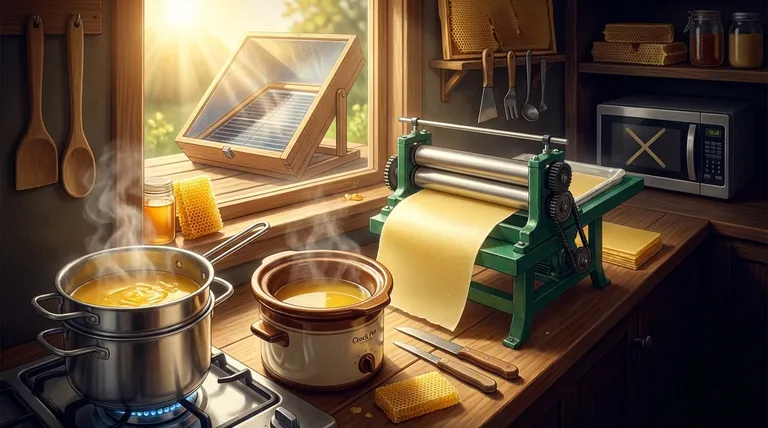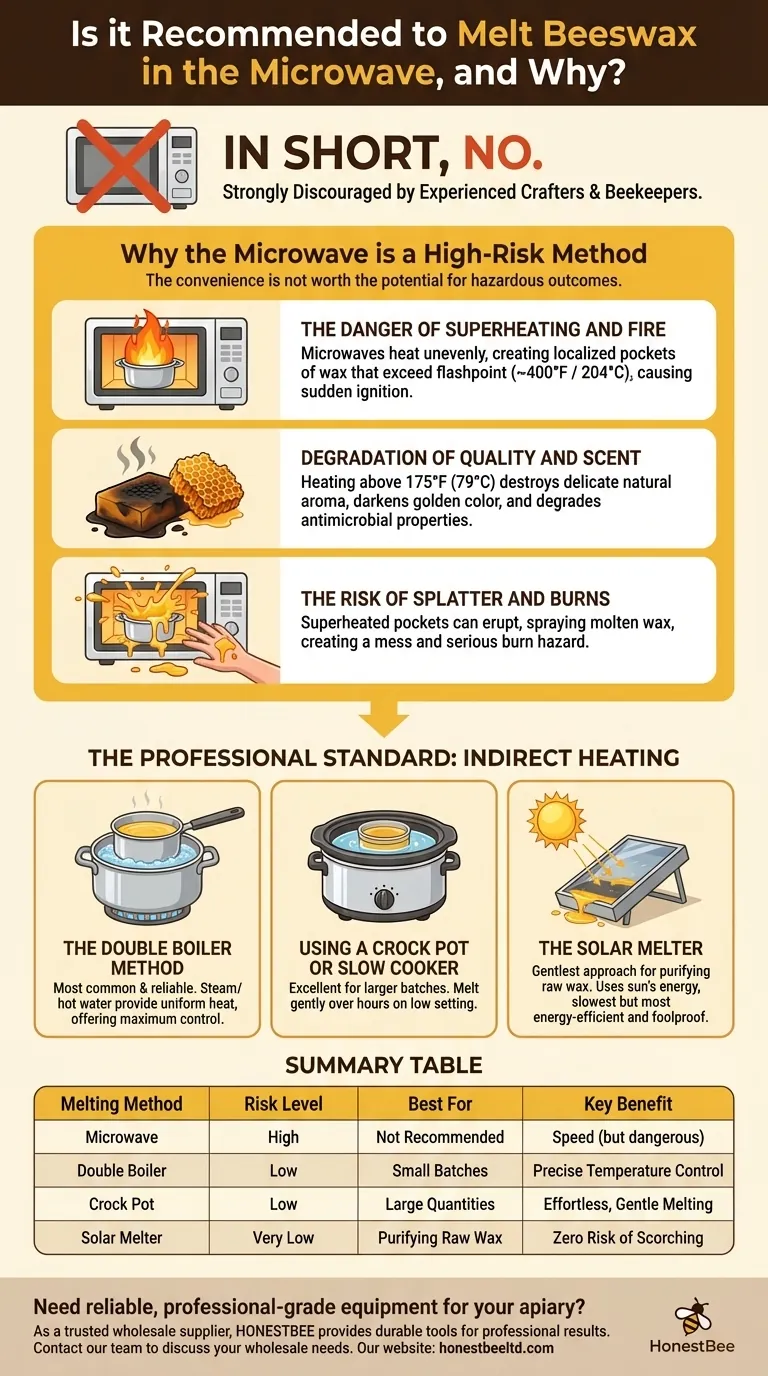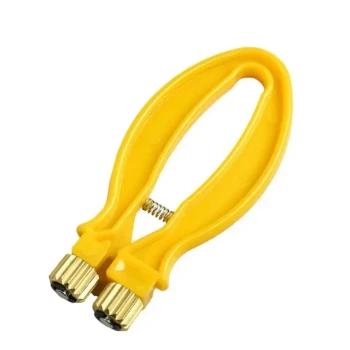In short, no. Melting beeswax in a microwave is strongly discouraged by experienced crafters and beekeepers. While technically possible, the process is notoriously difficult to control, creating significant risks of fire, personal injury, and damage to the wax itself. The speed of a microwave is not worth the potential for hazardous outcomes.
The core issue is uneven heating. Microwaves create superheated "hot spots" in the wax, which can flash into a fire or splatter violently, while other parts remain solid. Safer methods rely on slow, indirect heat to melt the wax uniformly and gently.

Why the Microwave is a High-Risk Method
The convenience of a microwave is tempting, but for beeswax, it introduces several dangers that are easily avoided with other methods. Understanding these risks is key to working safely.
The Danger of Superheating and Fire
Beeswax is a flammable material with a flashpoint around 400°F (204°C).
Microwaves heat unevenly, capable of creating localized pockets of wax that far exceed this temperature, even when the rest of the wax is not fully melted. This can cause the wax to ignite suddenly inside your appliance.
Degradation of Quality and Scent
Even if it doesn’t catch fire, overheating is detrimental to the beeswax.
Heating beeswax above 175°F (79°C) can destroy its delicate, natural aroma and may darken its desirable golden color. This high heat can also degrade the natural antimicrobial properties for which beeswax is valued.
The Risk of Splatter and Burns
The same uneven heating that causes fire risk can also cause the wax to splatter.
As pockets of wax superheat, they can erupt, spraying molten wax inside your microwave. This not only creates a difficult-to-clean mess but also presents a serious burn hazard when you open the door.
The Professional Standard: Indirect Heating
The safest and most effective methods all rely on a single principle: gentle, indirect heat. This allows the wax to melt slowly and evenly without scorching or reaching its flashpoint.
The Double Boiler Method
This is the most common and reliable method. A smaller pot or heat-safe bowl containing the beeswax is placed inside a larger pot of simmering water.
The steam and hot water provide uniform heat, giving you maximum control over the melting process. You can easily monitor the temperature and remove it from the heat once melted.
Using a Crock Pot or Slow Cooker
A slow cooker is an excellent tool for melting larger batches of beeswax with minimal effort.
Simply place your beeswax in a heat-safe container inside the crock pot, and then add water to the crock pot to create a water bath around the container. Set it to low, and the wax will melt gently over a few hours.
The Solar Melter
For the gentlest approach, especially when clarifying raw beeswax from the comb, a solar melter is ideal.
This device uses the sun's energy to slowly melt the wax, allowing it and impurities to separate naturally. It is the slowest method but also the most energy-efficient and foolproof against overheating.
Understanding the Trade-offs
Choosing your method involves balancing speed, safety, and the quality of your final product.
Speed vs. Safety
The microwave offers speed, but at the cost of safety. The risk of fire or burns from superheated wax is a significant liability that makes the time saved negligible.
Indirect heating methods are slower but provide a predictable and safe environment for working with a flammable material.
Convenience vs. Control
While a microwave is a convenient appliance, it offers almost no temperature control. This lack of control is precisely why it is a poor choice for a heat-sensitive material like beeswax.
A double boiler or crock pot gives you direct control over the heat source, allowing you to keep the wax within its ideal melting range of 145-175°F (63-79°C).
Essential Safety Precautions
Regardless of your chosen method, always work safely. Never leave melting wax unattended, use dedicated pots and utensils (as wax is very difficult to clean), and work in a well-ventilated area. Keeping a fire extinguisher rated for grease fires nearby is a wise precaution.
Making the Right Choice for Your Goal
Your project's needs should dictate your method.
- If your primary focus is safety and quality for small batches: Use a double boiler for precise temperature control.
- If your primary focus is melting larger quantities with minimal effort: A crock pot on low with a water bath is your most reliable option.
- If your primary focus is purifying raw wax with zero risk of scorching: A solar melter provides the gentlest heat source possible.
- If you are considering the microwave for a quick job: Stop. The severe fire risk and potential for ruined wax make it an unacceptable choice.
By prioritizing controlled, indirect heat, you ensure the safety of your workspace and preserve the natural quality of the beeswax for your project.
Summary Table:
| Melting Method | Risk Level | Best For | Key Benefit |
|---|---|---|---|
| Microwave | High | Not Recommended | Speed (but dangerous) |
| Double Boiler | Low | Small Batches | Precise Temperature Control |
| Crock Pot | Low | Large Quantities | Effortless, Gentle Melting |
| Solar Melter | Very Low | Purifying Raw Wax | Zero Risk of Scorching |
Need reliable, professional-grade equipment for your apiary? As a trusted wholesale supplier to commercial apiaries and distributors, HONESTBEE provides the durable tools you need to work safely and efficiently. From wax melters to full beekeeping kits, our products are designed for professional results. Contact our team today to discuss your wholesale needs and discover how we can support your business.
Visual Guide

Related Products
- Electric Beeswax Flat Sheet Machine with Operating Tray for Wax Processing
- Honey Wax Separating Wax Press with Metal Screw Wax Separator Machine
- Colorful Silicone Beeswax Foundation Mold Mould for Beekeeping
- 10L Stainless Steel Honey Wax Press Extractor for Wax Cappings
- 0.5T Capacity Honey Dehumidifier Dryer with Vacuum Heating and Thickening Filtering Machine
People Also Ask
- How do worker bees produce beeswax? A Guide to the Hive's Manufacturing Process
- What are the advantages of using industrial wax melters for beeswax? Achieve Scalable, Safe, and Consistent Production
- How does the beeswax flatting and embossing machine prepare the wax for processing? Achieve Perfectly Uniform Wax Sheets
- How does the machine flatten the beeswax? A Guide to Roller and Press Methods
- What are the main components of a beeswax foundation sheet machine? A Guide to Efficient Production


















